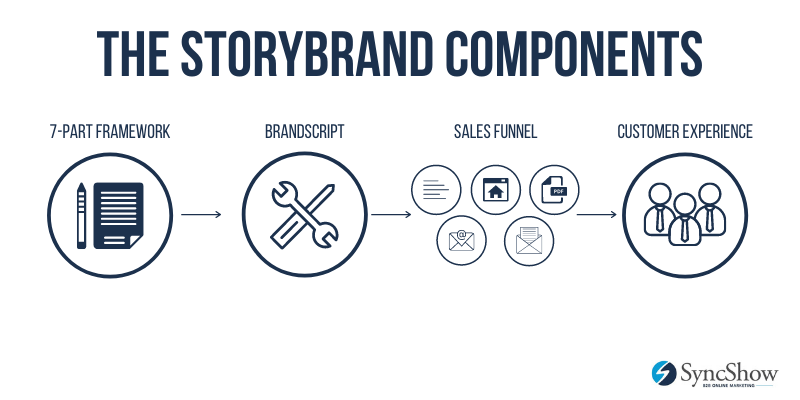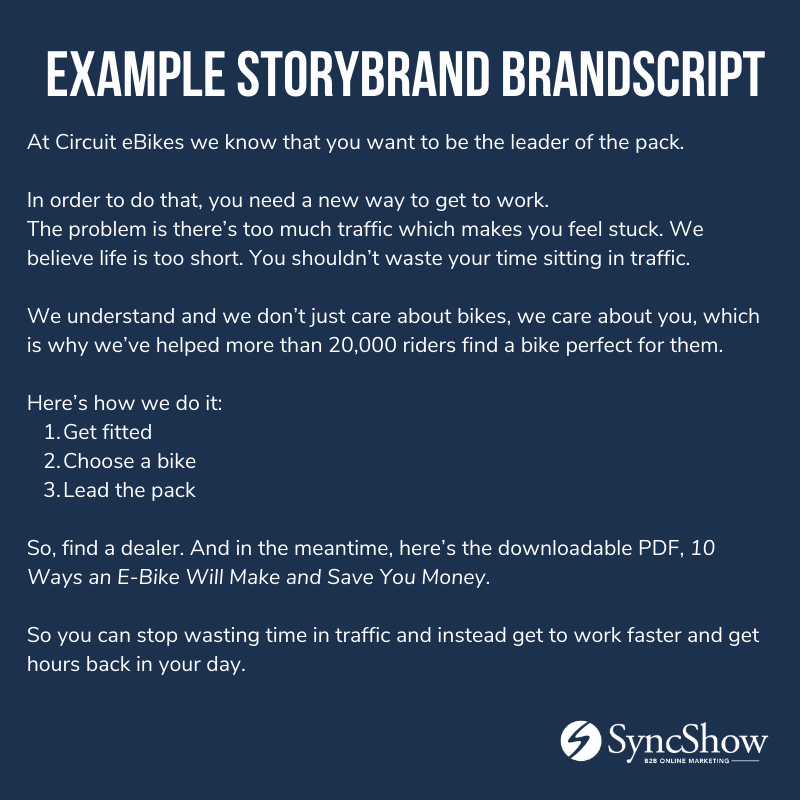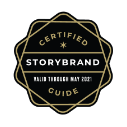Share this
How to Use the StoryBrand Framework to Grow Your Business
by Greg Lukach & John Julien on Mon, Oct 05, 2020 @ 10:30
Marketers can't seem to stop talking about the power of storytelling. More than ever, it's becoming a driving force in content marketing strategies that help grow businesses.
One of the most popular and powerful storytelling methodologies out there is Donald Miller's StoryBrand. Using a simple framework, StoryBrand leverages storytelling to help companies clarify (and simplify) marketing messages and create effective marketing plans that generate more leads.
This may seem like jargon that's only useful to marketers.
It's not.
As StoryBrand Certified Guides, we've used this methodology to help clients sell more online.
Here's how.
What Does StoryBrand Help You Achieve?
It's first important to understand what StoryBrand does.
Yes, StoryBrand helps you generate more online sales. But how?
Fundamentally, it does two things:
StoryBrand Helps Companies Overcome the Curse of Knowledge
When companies are so close to their products or services, they project that knowledge onto their customers. You see this all day, every day. Companies and organizations assume customers understand what they're saying, but they don't. This is a problem StoryBrand helps fix.
- A seven-part framework: StoryBrand uses seven categories of text (i.e., the StoryBrand framework) to help clarify your brand's messaging. This framework should be referenced to tell one consistent story throughout all marketing efforts.
- Your BrandScript: The seven-part framework is used to create a succinct script that tells your overarching brand story in a way that will resonate with your audience.
- Your StoryBrand sales funnel: These are the physical pieces of marketing collateral that will be used to tell your brand's story in a way that piques interest and closes more sales.

StoryBrand Helps Customers and Prospects "Conserve Calories" and Understand How They Can Survive and Thrive
The human brain is designed to do two things: conserve calories and help you survive and thrive.
When customers and prospects are reading your marketing messages, they're asking themselves, "How will this product or service help me survive and thrive?" It's part of how every person is hardwired.
As it relates to the B2B world, this translates into, “How will this product or service help me do my job better (survive) or allow my company to succeed (thrive)?”
This is why you need to associate your product or service with survival, and the StoryBrand messaging framework helps you do that.
If a reader is confused by your messaging or left unsure of how your product or service can benefit them, they'll start daydreaming. This is a survival mechanism. When people consume information that's not telling them how they can survive and thrive, their brains conserve calories and check out. This is why you need to develop clear messaging that puts the needs of your target audience first and keeps them engaged.
The Three Basic Tenets of StoryBrand
To help companies combat the curse of knowledge and understand how they can survive and thrive while conserving calories, StoryBrand adheres to these three tenets:
Always Position Your Customers as Heroes
The StoryBrand methodology relies on the fundamentals of storytelling because stories help people make sense of things. Stories are also formulaic and keep people intrigued over a period of time.
The central figure of every story is the hero. You always need to position your customers as heroes because no one wants to read about you—they only want to read about how you can benefit them and help them succeed. It's your job to help them become heroes in their personal narratives.
Always Associate Your Products and Services With the Survival of Your Customers
By doing this, you'll increase interest in your brand, and ensure customers and prospects see your products and services as being essential.
Never Use Language That's Cluttered or Hard to Process
If you're going to effectively associate your products and services with survival, you'll need to communicate using simple language that's easy to understand.
This means your messaging should be clear over clever. Cleverly worded marketing copy will produce confusion. Use simple sentence structures, adjectives and verbs that most people will understand. If a lot of your marketing copy consists of lengthy sentences with many commas and industry jargon, it may be time to rethink that copy.
As someone who knows your complicated business, you're going to want to make your messaging more complex than it should be. The StoryBrand framework can help you avoid this.
What Does the StoryBrand Seven-Part Framework Help You Achieve?
The StoryBrand framework is seven categories of text that work together to tell a consistent, compelling, simple story. When you craft your messaging strategy around your simplified story, you'll help your prospects stay engaged, eliminate confusion and help your prospects and customers know exactly how they're benefitting.
1. A Character
In the first part of the framework, you'll identify your ideal customer and define what they want. Remember, this ideal customer is the hero of your story. In the B2B space, this character should be a generalization of an ideal company you want to work with.
2. With a Problem
Stories contain conflict. That's why you should take the time to identify the three types of problems your ideal customer faces:
- External: What are the physical challenges your customers are struggling with?
- Internal: What are your ideal customers feeling that they aren't necessarily expressing?
- Philosophical: What injustices is your company or brand helping your character overcome?
3. Meets A Guide
Your story's hero needs a solution provider that will help them succeed.
That's you.
Your story should include all of the reasons you should be trusted to lead your customer to success. To do this, you need to express empathy and demonstrate authority, using testimonials, impressive statistics, industry certifications, etc. The key is to not go overboard when talking about yourself. Otherwise, you become the hero of the story.
4. Who Gives Them a Plan
Now that you've identified your hero's problems and have earned their trust, your story needs to tell them exactly how to work with you. Lay out a three- to five-step plan that explains what your process is and how it leads to their success.
5. That Calls Them to Action
At this point in the story, your hero should feel compelled to take action. They should be looking to "buy now" or "schedule an appointment."
Of course, not every customer will be ready to make a purchase. This is why it's important to provide these customers a different type of call to action that encourages additional education, whether that be to download an ebook or request a demo.
That Results In…
6. Success
Never assume people will know how your brand can change their lives. Tell them by offering a vision for how great their lives could be after buying your product or service.
7. And Helps Them Avoid Failure
If there's nothing at stake in this story, there is no story. This is why you need to communicate the cost of not doing business with you.
.png?width=600&name=The%20StoryBrand%20Framework%20(2).png)
What Does a BrandScript Help You Achieve?
Your StoryBrand BrandScript will pull from the seven categories of text in the framework to create messaging that directly communicates with targets in the right way to drive sales.
It will consist of simple, relevant and repeatable statements that will be used throughout —and drive—all of your messaging.
Here's an example of what a BrandScript can look like:

What Does a StoryBrand Sales Funnel Help You Achieve?
Once you have your BrandScript written, you can use it to create a sales funnel that includes five components:
- A corporate one-liner
- A homepage wireframe
- A lead-generating PDF (i.e., a sales sheet)
- A five-email sales-focused email campaign
- A sales letter
Your corporate one-liner should be one or two sentences of copy that pique the interest of prospects and generate interest. Your StoryBranded homepage will pull from every category of text in the seven-part StoryBrand framework to create an engaging experience that inspires website visitors to take action.
The other three sales funnel components nurture your website leads and help you close sales.
There are very specific ways to build out all of these components so that they follow the StoryBrand methodology and effectively incorporate the seven categories of text from the StoryBrand framework and your BrandScript.
To build out a StoryBrand sales funnel, you should rely on expert guidance.
Why Do You Need a StoryBrand Certified Expert?
B2B companies waste an enormous amount of money on marketing and messaging that doesn’t inspire prospects to make a purchase. This is often because internal decision-makers are so ingrained in the complexities of their business that they struggle with telling one simple story that will resonate with their target audience.
Creating simple, yet effective messaging is difficult. As Mark Twain infamously said, “I didn't have time to write a short letter, so I wrote a long one instead.”
As StoryBrand Certified Experts, we understand the importance of clear and concise messaging. We know what it takes to integrate complex, dynamic offerings into easy-to-understand, compelling stories.

StoryBrand Certified Experts receive education directly from Donald Miller and the StoryBrand team to hone in their skills. Additionally, they are given access to exclusive resources and a network of experts to stay on top of trends and best practices.
Reach out today to get started on simplifying your marketing message and turn your business into an online sales machine.
Share this
- Inbound Marketing (126)
- Manufacturing (82)
- Lead Generation (70)
- Website Design & Development (58)
- Social Media (46)
- Online Brand Strategy (39)
- eCommerce (33)
- B2B Marketing (32)
- Digital Marketing (30)
- Expert Knowledge (30)
- Company Culture (22)
- Content Marketing (17)
- Customer Experience (15)
- Metrics & ROI (15)
- Search Engine Optimization (15)
- Marketing and Sales Alignment (12)
- Transportation and Logistics (11)
- Content Marketing Strategy (9)
- Email Marketing (9)
- SyncShow (9)
- Digital Content Marketing (8)
- Digital Sales (8)
- General (8)
- Lead Nurturing (8)
- Mobile (7)
- Brand Awareness (6)
- Digital Marketing Data (4)
- Transportation Insights (4)
- Video Marketing (4)
- LinkedIn (3)
- Professional Services (3)
- Account-Based Marketing (2)
- Demand Generation (2)
- High Performing Teams (2)
- Marketing Automation (2)
- News (2)
- PPC (2)
- SEO (2)
- SSI Delivers (2)
- Synchronized Inbound (2)
- Value Proposition (2)
- Facebook (1)
- HubSpot (1)
- In-House Vs. Outsourced Marketing (1)
- Instagram (1)
- KPI (1)
- Networking (1)
- Paid Media (1)
- Retargeting (1)
- StoryBrand (1)
- Storytelling (1)
- March 2025 (1)
- January 2025 (4)
- December 2024 (2)
- November 2024 (4)
- October 2024 (4)
- September 2024 (4)
- August 2024 (4)
- July 2024 (1)
- June 2024 (1)
- May 2024 (4)
- April 2024 (1)
- March 2024 (3)
- January 2024 (2)
- December 2023 (4)
- November 2023 (3)
- October 2023 (1)
- September 2023 (4)
- August 2023 (3)
- July 2023 (2)
- June 2023 (2)
- August 2022 (2)
- July 2022 (2)
- June 2022 (1)
- March 2022 (2)
- February 2022 (1)
- January 2022 (2)
- October 2021 (1)
- June 2021 (1)
- May 2021 (1)
- March 2021 (1)
- December 2020 (1)
- October 2020 (2)
- September 2020 (1)
- August 2020 (3)
- July 2020 (3)
- June 2020 (4)
- May 2020 (2)
- April 2020 (3)
- March 2020 (9)
- February 2020 (5)
- January 2020 (6)
- December 2019 (5)
- November 2019 (7)
- October 2019 (6)
- September 2019 (8)
- August 2019 (5)
- July 2019 (5)
- June 2019 (3)
- May 2019 (2)
- April 2019 (1)
- March 2019 (2)
- February 2019 (1)
- January 2019 (2)
- November 2018 (1)
- October 2018 (1)
- September 2018 (1)
- August 2018 (1)
- May 2018 (2)
- March 2018 (1)
- November 2017 (1)
- October 2017 (1)
- September 2017 (1)
- August 2017 (2)
- July 2017 (2)
- May 2017 (1)
- April 2017 (1)
- February 2017 (1)
- January 2017 (1)
- December 2016 (1)
- November 2016 (8)
- October 2016 (7)
- September 2016 (2)
- August 2016 (2)
- July 2016 (6)
- June 2016 (3)
- May 2016 (4)
- April 2016 (6)
- March 2016 (6)
- February 2016 (7)
- January 2016 (7)
- December 2015 (6)
- November 2015 (2)
- October 2015 (3)
- September 2015 (2)
- August 2015 (4)
- July 2015 (9)
- June 2015 (9)
- May 2015 (8)
- April 2015 (8)
- March 2015 (9)
- February 2015 (7)
- January 2015 (8)
- December 2014 (7)
- November 2014 (7)
- October 2014 (5)
- September 2014 (4)
- August 2014 (4)
- July 2014 (5)
- June 2014 (4)
- May 2014 (5)
- April 2014 (4)
- March 2014 (7)
- February 2014 (9)
- January 2014 (7)
- August 2013 (2)
- July 2013 (4)
- June 2013 (6)
- May 2013 (7)
- April 2013 (7)
- March 2013 (8)
- February 2013 (5)
- January 2013 (7)
- December 2012 (4)
- November 2012 (4)
- October 2012 (2)
- September 2012 (1)
- July 2012 (1)
- April 2012 (4)
- March 2012 (5)
- February 2012 (2)
- January 2012 (3)
- November 2011 (1)
- May 2011 (3)
- April 2011 (1)
- March 2011 (1)
- February 2011 (1)
- December 2010 (2)
- November 2010 (3)
- August 2010 (1)
- July 2010 (1)
- May 2010 (2)
- April 2010 (1)
- January 2010 (1)




